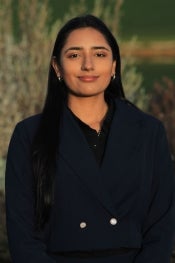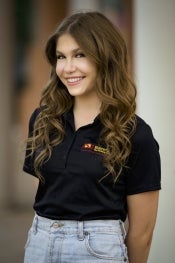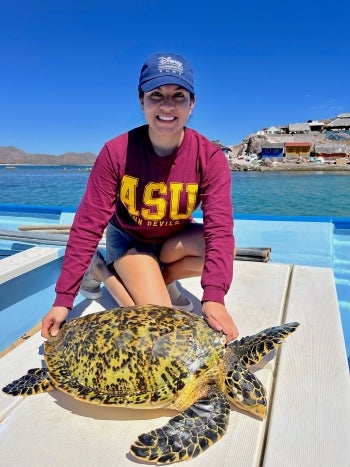3 ASU students win first place in poster contest at world's largest general science conference

The three winners of the AAAS poster contest (from left): Naina Misra, Sophia Koutsogiannis and Cindy Vargas. Courtesy photos
Three Arizona State University students have won first place in their respective categories in the annual poster competition hosted at the American Association for the Advancement of Science (AAAS) conference, the largest general science conference in the world. Each of them has earned a $500 cash prize and will have a copy of their poster published in the April 19 issue of the journal Science.
Naina Misra, a third-year biomedical engineering student in Barrett, The Honors College, won first prize in the Science and Society category for undergraduate students. Her poster had to do with how accommodating multiple dietary options can make free food events more inclusive. Though Misra hopes to one day pursue neurosurgery or neurology, she is happy to have had the chance to do research about making campus events more inclusive to people with different diets, especially since she is a vegetarian herself.
“I think this is a topic that isn’t really talked about as much ... so it was great to spread more awareness about this project and get more people interested in the work that we’re doing," Misra said.
This was Misra’s first time ever presenting a poster at a science conference, which makes her win all the sweeter: “It feels really good. I'm just happy to know that all the hard work that I put into this project paid off.”
Sophia Koutsogiannis, a third-year student in Barrett, The Honors College who is majoring in both biology and anthropology, won first prize in the Developmental Biology, Genetics, and Immunology category for undergraduate students.
“I wasn’t positive that I would win, because there are so many other really awesome competitors," she said. "So I was just really excited when I found out that I won first place.”
She investigated ways to combat insecticide resistance, or the phenomenon of insects evolving to the point where insecticides don’t harm them, in a specific species of mosquito. Specifically, Koutsogiannis considered whether removing an insecticide from a mosquito’s environment could help turn back the clock on resistance but found that doing so likely would not be a solution.
After finishing her bachelor’s degree, she plans to pursue a PhD in either evolutionary biology or paleontology, fields that she thinks her undergraduate research experiences have well prepared her for.
This is Koutsogiannis’s third time presenting a research poster, but the largest conference she’s done so at. She conducted the first-prize winning research with The Huijben Lab, a group that Koutsogiannis said she is “really grateful ... (to) be a part of.”
Cindy Vargas, a third-year PhD student in the Environmental Life Sciences program, won first prize in the Social Science category for graduate students. Her poster presented the results of a literature review on studies evaluating bycatch reduction technologies (BRTs), or tools made to reduce the number of creatures that fishermen accidentally catch in their nets.
She found that BRTs are effective but often evaluated without considering factors that are most relevant to the fishermen who’d actually be using the tools, like cost or safety. She argued that conservationists need to take fishermen into greater account in discussion of bycatch reduction technologies.
“What I really wanted to show is that future research shouldn’t just incorporate all of these ... metrics, but also include the social implications ... given that fishers are primarily the ones who will be using these technologies,” she said.
Vargas isn’t just making this argument –– she’s actively taking steps to include fishermen in the process of conservation herself. She conducts fieldwork in Baja California Sur, Mexico, where she works with fishermen to run experiments to see how the spacing of LED lights placed on yellowtail fishing nets (a proven BRT) could reduce the number of sea turtles accidentally caught in the nets. Not only is she continuing to test BRTs, she’s also getting feedback from fishermen on how to continue developing such tools.
“To have (the fishermen’s) consideration in every part of this project is important. Because we want them to feel included," Vargas said. "This should be a collaboration project, not just dictated by the scientists, but also involving the community and the fishers themselves.”
More Science and technology

4 ASU researchers named senior members of the National Academy of Inventors
The National Academy of Inventors recently named four Arizona State University researchers as senior members to the prestigious organization.Professor Qiang Chen and associate professors Matthew…

Transforming Arizona’s highways for a smoother drive
Imagine you’re driving down a smooth stretch of road. Your tires have firm traction. There are no potholes you need to swerve to avoid. Your suspension feels responsive. You’re relaxed and focused on…

The Sun Devil who revolutionized kitty litter
If you have a cat, there’s a good chance you’re benefiting from the work of an Arizona State University alumna. In honor of Women's History Month, we're sharing her story.A pioneering chemist…




